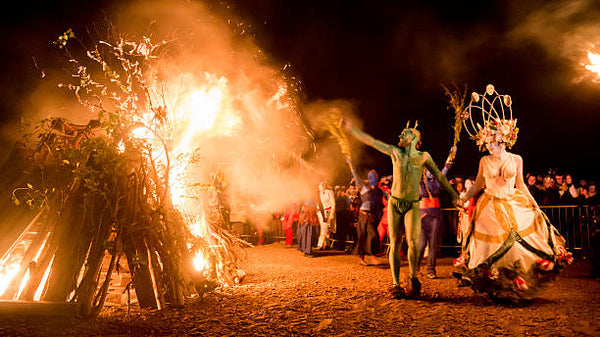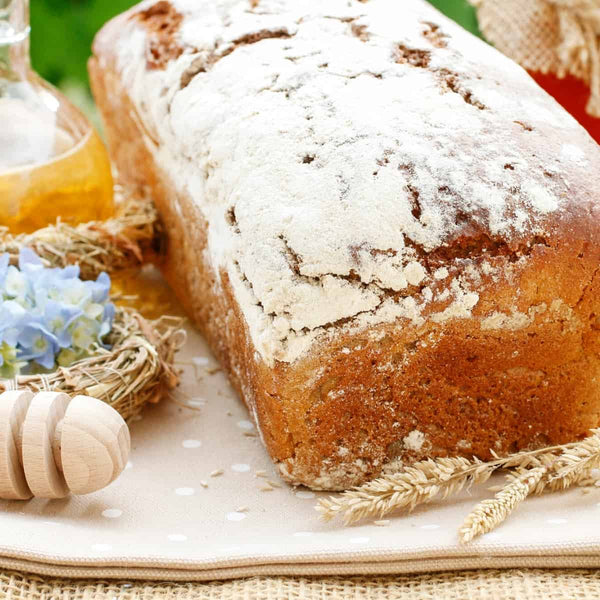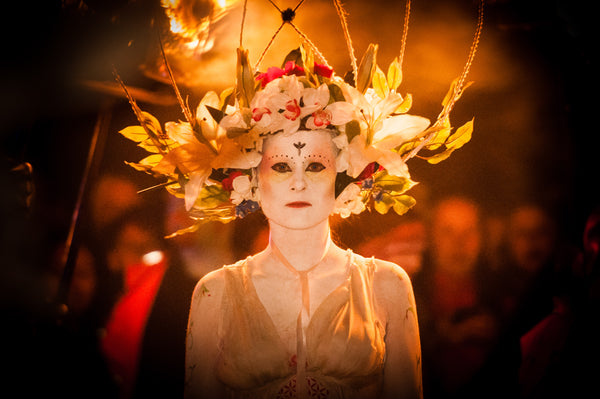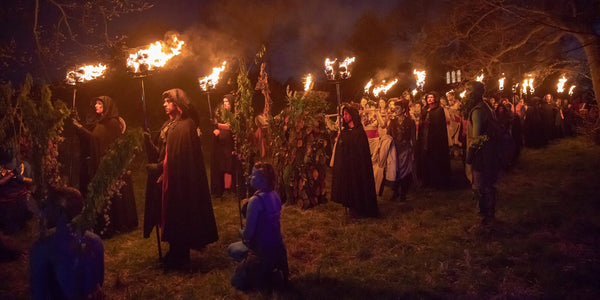Beltane: The Festival of Fire, Fertility, and Abundance
(May 1st / May Day)
Beltane, celebrated on the 1st of May, heralds the beginning of summer with its rich tapestry of history, vibrant customs, and deep spiritual significance. This ancient Celtic festival, one of the four major Sabbats within the Wheel of the Year, is steeped in traditions of fertility, fire, and the celebration of life's abundance. Beltane marks a time when the veil between the worlds is thin, allowing a closer connection to the earth and the spiritual realm, celebrating the union of the Goddess and the God, and by extension, the union of earth and sun, promising fertility for the coming summer.
Originally observed with bonfires, maypole dances, and rituals to bring fertility to the land and the community, Beltane encourages the lighting of fires to symbolize the return of life and passion. These fires were once jumped over to bring good fortune and purify participants, a testament to the transformative power of fire. The festival's focus on the bursting vitality of life makes it a perfect time to celebrate nature's lushness and invoke prosperity and growth.
In today's practice, Beltane offers a rich opportunity for modern Pagans and spiritual practitioners to weave ancient customs with contemporary life. Whether celebrated in groups with traditional maypole dances and communal feasting or observed in solitude with personal rituals to honor the season, Beltane's themes of renewal and vitality remain poignant. This article will explore the historical roots of Beltane, offer a guide to conducting both communal and solitary celebrations, and delve into the festival's enduring spiritual significance. By the end, readers will have a deeper understanding of how to integrate these timeless practices into their modern celebrations of Beltane, embracing the joy and abundance of the season.

The Green Man and the May Queen
Historical Background of Beltane
Beltane, originally a Gaelic tradition, marks one of the four major Sabbats within the Celtic calendar, emphasizing the transition from spring to summer. Historically, this festival played a crucial role in agricultural societies where the cycles of planting and harvesting dictated the rhythm of life.
Beltane's origins are entrenched in ancient rituals that celebrated the life-giving properties of the sun with bonfires, believed to offer protection and purification. These fires, symbols of the sun's returning vigor, were seen as a catalyst to boost the fertility of the fields and secure the prosperity of the community. The livestock were driven between fires to cleanse them before being led to summer pastures - a practice deeply rooted in the pastoral traditions of the Celts.
As centuries passed, the celebration of Beltane evolved, influenced by shifting religious and social paradigms. Initially a predominantly pagan festival characterized by its fire rituals and the honoring of natural deities, Beltane underwent significant transformations, particularly as christianity spread across Europe. Many Pagan practices were either adapted to fit christian observances or faded into the background, only to be revitalized by Neopagan communities in the modern era.
Today, Beltane continues to be celebrated by various Pagan and Neopagan groups, who have rekindled interest in its traditional roots while adapting its observance to contemporary spiritual contexts. The festival now not only honors historical Celtic customs but also embraces a broader interpretation of spirituality and community, reflecting its ability to transcend time and adapt to the evolving needs of its practitioners.

Burning of the Wicker Man, Butser Ancient Farm, England, 2019 (Owner Benjamin attended this event)
Beltane Rituals and Traditions
Beltane, rich with history and vibrant customs, offers a plethora of ways for both solitary practitioners and groups to honor and celebrate the festival's themes of fire, fertility, and renewal. Below, you will find detailed guidance on solitary practices, ideas for group celebrations, and creative crafts and decorations that encapsulate the spirit of Beltane.
Solitary Practices
For solitary practitioners, celebrating Beltane can be a deeply personal and transformative experience. Begin by setting up an altar that resonates with the themes of Beltane. Decorate it with symbols of fertility and renewal such as flowers, greenery, and images or symbols of deities associated with Beltane, like the goddess Flora or the Green Man. Candles in shades of green, red, and yellow can represent the fire element and the sun's energy, essential to this festival.
Performing a fire ritual safely at home involves either lighting candles or, if space and safety permit, creating a small fire in a fireproof container. This act symbolizes the Beltane fire's traditional role in protection and purification. As you light the fire, focus on your intentions for personal growth and fertility in aspects of your life. This could mean physical fertility, but also creative or project-based fertility—anything that you wish to grow and flourish.
Meditation during Beltane should focus on personal renewal and growth. Spend time visualizing your life blossoming with the full force of spring's power. Reflect on what you wish to manifest and draw into your life in the coming months, imbuing your intentions with the vibrant energy of the season.
Group Celebrations
Beltane is traditionally a community festival, and celebrating in a group can be a joyful way to observe the day. Maypole dancing is a quintessential Beltane activity that symbolizes fertility with its intertwining ribbons and soaring pole, representing the union of the earth and sky. This can be a communal project, with participants dancing and weaving ribbons around a central pole.
Creating a communal bonfire is another powerful way to mark Beltane with a group. This can serve as a focal point for the celebration, around which participants can gather to perform rituals, share stories, and dance. The fire serves to unite the community and acts as a symbolic cleanser, purging negativity and inviting in positivity and growth.
Crafts and Decorations
Engaging in the creation of traditional Beltane crafts is a wonderful way to physically connect with the festival’s spirit. Flower crowns are popular and can be made from fresh flowers and greenery, embodying the beauty and fertility of spring. May baskets, filled with flowers, treats, or small gifts, can be crafted and hung on doors or exchanged with friends as tokens of goodwill and friendship.
Decorating your home or ritual space with symbols of fertility and abundance helps to align your environment with Beltane’s themes. Consider draping green and vibrant cloths, placing bowls of fresh fruits, or crafting garlands from flowers and greenery to adorn your space.
By incorporating these rituals, celebrations, and crafts into your Beltane observance, whether alone or with others, you can fully embrace the rich symbolism and joy of this ancient festival, celebrating the exuberant vitality and renewal that it heralds.

Beltane Foods and Feasting
Beltane is not only a festival of fire and fertility but also a celebration of abundance and nourishment. The foods traditionally associated with Beltane reflect the renewal of the earth and the richness of the season. Here we explore the customary dishes, provide recipes for celebration, and discuss the ritualistic significance of feasting during this joyful sabbat.
Traditional Foods
Beltane feasts often include foods that incorporate fresh, seasonal ingredients available after the long winter months. Oat cakes, a staple during Beltane, symbolize the sun and the wheel of the year because of their round shape. They are traditionally eaten during the festival to bring blessings of prosperity and protection. Dairy dishes such as custards and creams are also significant due to the historical beginning of the milking season during Beltane; these foods honor the abundance of nourishment provided by livestock. Green salads made with fresh, young leaves gathered at this time of year symbolize the greening of the earth and the spread of fertile life across the land.
Recipes for Celebration
To celebrate Beltane, consider preparing dishes that highlight fresh, vibrant ingredients. A simple yet delicious recipe is a spring green salad featuring baby spinach, fresh peas, and edible flowers, dressed with a light vinaigrette. Another Beltane favorite could include oat cakes served with a dollop of honeyed cream, combining the grounding energy of oats with the luxurious richness of dairy, sweetened by the first honey of the season. For something more substantial, try a herbed barley pilaf or quiche with fresh herbs such as parsley, chives, and thyme, which are plentiful during this time of year.
Feasting as a Ritual
At Beltane, preparing and sharing food transcends mere consumption and becomes a communal ritual that fosters connection and unity. In group settings, each participant might contribute a dish, creating a potluck that represents the collective bounty and diversity of the community. This act of sharing food strengthens communal bonds and acts as an expression of generosity and gratitude for the earth’s abundance. For solitary practitioners, preparing a meal with intention and then offering a portion to the earth or deities can be a powerful act of spiritual communion and gratitude, reinforcing the bond between the individual and the natural world.
By engaging in these culinary traditions and sharing them with others, Beltane becomes a deeply meaningful celebration of life’s sweetness and abundance, rooted in the joyous energies of the season.

The May Queen
The Spiritual Significance of Beltane
Beltane holds profound spiritual significance within the Pagan and Wiccan traditions, embodying themes of renewal, purification, and the harmonious balance between elements such as fire and water. This festival offers a time to celebrate the full blossoming of spring and prepare for the energetic high point of summer. As we explore these deeper spiritual themes, we can also discover ways Beltane can foster personal growth and a deeper connection with the natural world.
Themes of Beltane
The central theme of Beltane is renewal. As the earth bursts into vibrant life, Beltane invites us to renew our own energies and aspirations. It is a time of purification, a theme traditionally enacted through the Beltane fire. The fire, representing action and transformation, burns away the remnants of the past season, purifying our intentions and energizing us for the active months ahead. Water, on the other hand, symbolizes emotion and intuition. Its role during Beltane is to cleanse and bless the new life growing around us and within us, offering a balance to the fiery energy of the festival. This balance between fire (action) and water (emotion) encourages a harmonious flow between our desires and feelings, fostering alignment and well-being.
Personal Growth
Beltane is an ideal time for personal reflection and setting intentions. The energy of renewal and the vibrant forces of nature inspire us to focus on self-improvement and personal growth. During Beltane, consider engaging in meditative practices that reflect on your past achievements and future goals. Setting intentions during this time can involve writing down what you wish to cultivate in your life, whether it’s starting new projects, nurturing relationships, or fostering personal health and happiness. Rituals that involve planting seeds are particularly symbolic during Beltane; they not only represent the fertility of the earth but also the growth we wish to see in ourselves. Each seed planted can symbolize a specific intention, carefully nurtured in the coming months.
Connecting with Nature
Beltane’s celebration is deeply rooted in the earth's fertility and the life it sustains. Connecting with nature is a key aspect of celebrating this sabbat. Practitioners might choose to take walks in nature to gather wildflowers or simply spend time outdoors to absorb the revitalizing energy of the earth awakening from winter’s slumber. These activities not only honor the spirit of Beltane but also remind us of our place within the natural cycle, fostering a sense of unity with all living things. Additionally, engaging in gardening or visiting natural springs can be powerful ways to connect physically and spiritually with the earth’s abundant life force during this festive time.
By embracing the spiritual themes of Beltane, practitioners can experience profound renewal and joy, deepening their connections with themselves, their community, and the vibrant earth around them.

Beltane Fire festival
Conclusion
As we've explored throughout this guide, Beltane is a festival rich in history, tradition, and spiritual significance, deeply rooted in the Celtic celebration of the fertility of the earth and the return of summer. This ancient festival, with its vibrant fires, lush symbolism of growth and fertility, and communal joy, offers a powerful reminder of life's renewal and the potent energies that springtime brings.
Beltane's adaptability to modern practices allows both solitary practitioners and groups to find meaningful ways to celebrate. Whether through crafting personal rituals, engaging in traditional crafts, or simply gathering in celebration with others, Beltane provides numerous opportunities for individuals to connect with this season's dynamic spirit. The rituals and customs associated with Beltane, from the Maypole dance to the lighting of bonfires, serve not only as links to our ancestors but also as vibrant expressions of community and personal growth today.
We encourage you to embrace the joyous spirit of Beltane with openness and enthusiasm. Let this festival inspire you to ignite your own inner fires of creativity, love, and intention. Whether you choose to focus on the fertility of the earth or the fires of aspiration, Beltane invites you to celebrate the abundance and potential within and around you.
As you personalize your Beltane celebrations, consider integrating your unique traditions, innovations, and contemporary adaptations to honor this ancient yet ever-relevant festival. Whether you are crafting a solitary ritual in a quiet natural setting or joining a bustling community celebration, make this Beltane a reflection of your personal spiritual journey and community connections.
Let this Beltane be a time of joy, renewal, and profound connection to the cycles of nature. Embrace the rituals, embrace the community, and most importantly, embrace the transformative power of this enchanting season. Happy Beltane! May your celebrations be filled with magic, growth, and abundant joy.
Photo Credit: The majority of images in this article have been taken from the Beltane Fire Society and their website can be found here: https://beltane.org/














Leave a comment (all fields required)